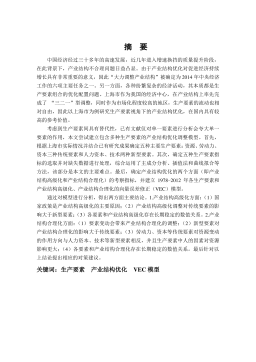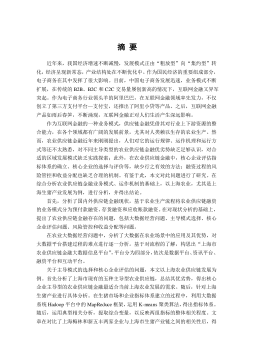小波图像处理技术及其在转子流量计读数中的应用
摘要图像测量技术是将图像处理技术与传统的测量方法有机结合的一种组合测量技术,属于非接触式测量范畴。无论是传统的测量还是基于图像处理的测量,测量结果的精度、可靠度都必需满足一定的要求。图像测量技术实际测量效果的好坏与所采用的图像处理技术密切相关。而其所采用的图像处理技术,主要包括图像去噪技术和图像增强技术。传统的去噪和增强方法大多只适合某一特定应用场合,且只能反映信号的时域或频域信息。而小波去噪和增强技术以小波的多分辨率分析为基础,兼顾了信号的时域和频域特性,能达到不同的处理效果。但是小波去噪和增强实际操作中的小波基选择和小波系数处理方法的选择仍有待改善。本文首先介绍了小波分析理论及其图像处理技...
相关推荐
-
我国基层财政困难的制度成因分析与对策研究VIP免费

 2024-09-20 46
2024-09-20 46 -
我国煤电产业链纵向交易合约机制研究VIP免费

 2024-09-20 44
2024-09-20 44 -
生产要素视角下的上海市产业结构优化研究VIP免费

 2025-01-09 8
2025-01-09 8 -
我国银行业结构与经济结构关系研究VIP免费

 2025-01-09 18
2025-01-09 18 -
大数据视角下农业供应链金融研究VIP免费

 2025-01-09 14
2025-01-09 14 -
跨国大型综合超市的规划研究VIP免费

 2025-01-09 9
2025-01-09 9 -
跨境电商农产品质量安全问题研究VIP免费

 2025-01-09 9
2025-01-09 9 -
世界市场的虚拟化与我国国际电子商务发展方向研究VIP免费

 2025-01-09 46
2025-01-09 46 -
中国政府对电力行业的价格规制问题研究VIP免费

 2025-01-09 20
2025-01-09 20 -
中小企业信息化系统集成技术研究VIP免费

 2025-01-09 30
2025-01-09 30
相关内容
-

跨国大型综合超市的规划研究
分类:高等教育资料
时间:2025-01-09
标签:无
格式:PDF
价格:15 积分
-

跨境电商农产品质量安全问题研究
分类:高等教育资料
时间:2025-01-09
标签:无
格式:PDF
价格:15 积分
-

世界市场的虚拟化与我国国际电子商务发展方向研究
分类:高等教育资料
时间:2025-01-09
标签:无
格式:PDF
价格:15 积分
-

中国政府对电力行业的价格规制问题研究
分类:高等教育资料
时间:2025-01-09
标签:无
格式:PDF
价格:15 积分
-

中小企业信息化系统集成技术研究
分类:高等教育资料
时间:2025-01-09
标签:无
格式:PDF
价格:15 积分





